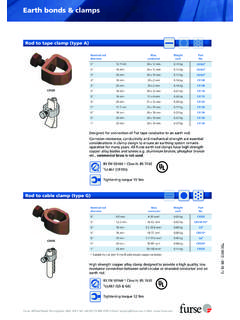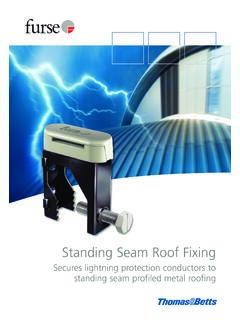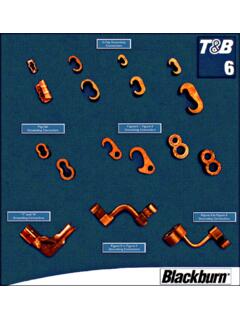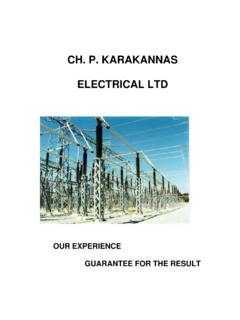Transcription of Technical Guide - TNB.COM
1 Technical Guide Photo-electronic Controls forAmenity, Street & Highway LightingThe content of this Thomas & Betts publication has been carefully checked for accuracy at the time of print. However, Thomas & Betts doesn t give any warranty of any kind, express or implied, in this respect and shall not be liable for any loss or damage that may result from any use or as a consequence of any inaccuracies in or any omissions from the information which it may contain. E& Thomas & Betts 2014. Royce Thompson is a brand of Thomas & Betts. Copyright in these pages is owned by Thomas & Betts except where otherwise indicated. No part of this publication may be reproduced, copied or transmitted in any form or by any means, without our prior written permission.
2 Images, trade marks, brands, designs and technology are also protected by other intellectual property rights and may not be reproduced or appropriated in any manner without written permission of their respective owners. Thomas & Betts reserves the right to change and improve any product specifications or other mentions in the publication at its own discretion and at any time. These conditions of use are governed by the laws of the Netherlands and the courts of Amsterdam shall have exclusive jurisdiction in any Member of the ABB GroupA Member of the ABB Group50 CELEBRATINGYEARSIN INDUSTRYCELEBRATINGYEARSIN OFFICE Thomas & Betts LimitedRoyce ThompsonBruntcliffe LaneLeedsWest YorkshireLS27 9 LLUnited Kingdom Tel +44 (0)113 281 0600 Fax +44 (0)113 281 0601 EUROPEAN HEADQUARTERS Thomas & BettsEuropean Centre SA200 Chauss e de Waterloo B-1640 Rhode-St-Gen seBelgium Tel +32 (0)2 359 8200 Fax +32 (0)2 359 8201 MIDDLE EAST OFFICE Thomas & Betts Ltd.
3 724 6WA West WingDubai Airport Free ZonePO Box 54567 DubaiUnited Arab Emirates Tel +971 (0)4 609 1635 Fax +971 (0)4 609 1636 SOUTH EAST ASIA OFFICE Thomas & Betts Asia(Singapore) Pte Ltd10 Ang Mo Kio Street 65 #06-07 TechpointSingapore 569059 Tel +65 6720 8828 Fax +65 6720 8780 Thompson is the leading photo-electronic lighting controls brand from Thomas & Betts, supporting the street and amenity lighting industry since those fifty years at the forefront of the photo-electronic lighting controls market, the Royce Thompson brand has achieved many firsts, including the first solid state photocell in the 1970 s, followed by the first use of synchronous switching and ASIC microprocessor control technology in the 1990 focus on the provision of high quality.
4 Innovative products to the market ensures Royce Thompson photocells offer the best possible value in terms of low energy consumption, reliability and long service life - helping you, the customer, achieve optimum performance whilst keeping your carbon footprint to a Thompson PhotocellsA photocell (or Photo-Electronic Control Unit - PECU ) is an electronic switch which is triggered at a specific light level. Based on thermal, electronic or microprocessor technology, photocells operate in a number of ways depending of the level of accuracy required. These are:n Dusk to dawn sensing - generally inaccurate light detection where the lamp switches ON as night falls and switches OFF shortly after Light level detection - more accurate light detection where the photocell switches at pre-set light levels both at sunset and sunrise, typically 70/35, 55/28, 35/18 or 20/20 lux.
5 Negative switching sets the lamp to OFF at a lower level than ON , with positive switching acting in Part Night operation - uses the same technology as photocells with light level detection, but also includes an in-built clock for midnight switching OFF and BST/GMT seasonal Thompson photocells are available in a number of configurations, with light level detection or Part Night operation, to meet the various needs of the street and amenity lighting market, including:n One Part NEMA photocell - the photo-electronic control is housed in a polycarbonate casing with a UV stabilised plastic cone, with base fixing to a NEMA socket as standard, or with optional flying One Part miniature photocell - including a standard miniature casing, ideal for use where installation space is limited or minimum aesthetic impact is Two Part remote photocell - enables placement of the lens to monitor light levels, whilst the controller is placed within reach in the lighting unit to permit functional Two Part miniature photocell - allows both remote placement of the lens.
6 And installation of the miniature controller in lamps where space is , selection of the most appropriate photocell for the installation is determined by the performance, energy savings and value for money required from the controlling photocell switching, the Royce Thompson range is further divided into two types, with two relay options:n Microprocessor based photocell - ensures highly accurate switching, positive and negative switch differential and a controlled OFF level, from a choice of monostable or bi-stable switching Photocell control by discrete component - for a low cost, simple solution to photo-electronic control, with suitability for positive switch differential only and an uncontrolled OFF level, from a monostable monostable relay is energised within the photocell throughout the time that the load is switched ON.
7 This results in higher power bi-stable relay delivers a voltage pulse to change the load state from ON to OFF and vice versa. This reduces the overall power consumption and results in a lower overall cost to the INDUSTRYCELEBRATINGYEARSIN INDUSTRYR oyce ThompsonPhotocell Configurations Thomas & Betts Royce Thompson, Bruntcliffe Lane, Leeds, LS27 9 LLTel: +44 (0)113 281 0600 Email: & Betts Royce Thompson, Bruntcliffe Lane, Leeds, LS27 9 LLTel: +44 (0)113 281 0600 Email: Thompson PhotocellsRoyce Thompson is the leading photo-electronic lighting controls brand from Thomas & Betts, supporting the street and amenity lighting industry since those fifty years at the forefront of the photo-electronic lighting controls market, the Royce Thompson brand has achieved many firsts, including the first solid state photocell in the 1970 s, followed by the first use of synchronous switching and ASIC microprocessor control technology in the 1990 focus on the provision of high quality, innovative products to the market ensures Royce Thompson photocells offer the best possible value in terms of low energy consumption, reliability and long service life - helping you.
8 The customer, achieve optimum performance whilst keeping your carbon footprint to a Thompson PhotocellsA photocell (or Photo-Electronic Control Unit - PECU ) is an electronic switch which is triggered at a specific light level. Based on thermal, electronic or microprocessor technology, photocells operate in a number of ways depending of the level of accuracy required. These are:n Dusk to dawn sensing - generally inaccurate light detection where the lamp switches ON as night falls and switches OFF shortly after Light level detection - more accurate light detection where the photocell switches at pre-set light levels both at sunset and sunrise, typically 70/35, 55/28, 35/18 or 20/20 lux.
9 Negative switching sets the lamp to OFF at a lower level than ON , with positive switching acting in Part Night operation - uses the same technology as photocells with light level detection, but also includes an in-built clock for midnight switching OFF and BST/GMT seasonal Thompson photocells are available in a number of configurations, with light level detection or Part Night operation, to meet the various needs of the street and amenity lighting market, including:n One Part NEMA photocell - the photo-electronic control is housed in a polycarbonate casing with a UV stabilised plastic cone, with base fixing to a NEMA socket as standard, or with optional flying One Part miniature photocell - including a standard miniature casing, ideal for use where installation space is limited or minimum aesthetic impact is Two Part remote photocell - enables placement of the lens to monitor light levels, whilst the controller is placed within reach in the lighting unit to permit functional Two Part miniature photocell - allows both remote placement of the lens.
10 And installation of the miniature controller in lamps where space is , selection of the most appropriate photocell for the installation is determined by the performance, energy savings and value for money required from the controlling photocell switching, the Royce Thompson range is further divided into two types, with two relay options:n Microprocessor based photocell - ensures highly accurate switching, positive and negative switch differential and a controlled OFF level, from a choice of monostable or bi-stable switching Photocell control by discrete component - for a low cost, simple solution to photo-electronic control, with suitability for positive switch differential only and an uncontrolled OFF level, from a monostable monostable relay is energised within the photocell throughout the time that the load is switched ON.
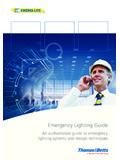



![Print wsd-ac03236[1].tiff (2 pages) - TNB.COM](/cache/preview/5/f/c/5/3/b/f/4/thumb-5fc53bf4fad2d750289817c985b291cf.jpg)
